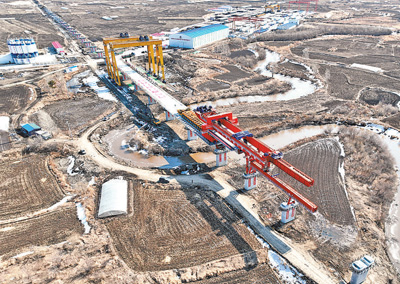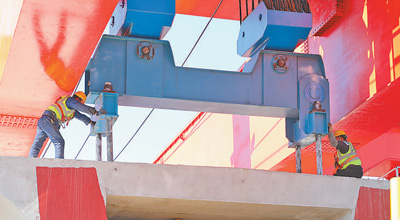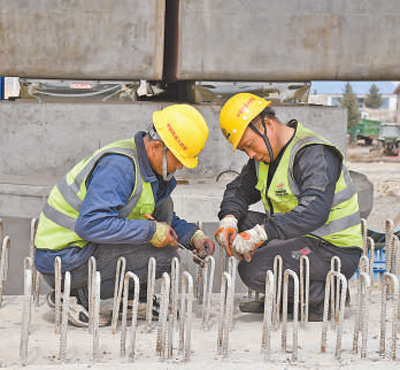
 |
|
The bridges on the Kazakhstan section of the Haiyi high-speed railway are being moved forward and put into place. |
 |
|
Construction workers are preparing to move the bridge forward. |
 |
|
Construction workers are adjusting the steel bars attached to the bridge deck. |
core reading
In recent years, the builders of the Haiyi High-speed Railway, the northernmost high-speed railway currently being built in my country, have solved the problem of frozen soil in cold regions, continued to innovate technology, and strictly controlled construction quality. With their hard work and sweat, they have built a solid foundation for the rapid development of transportation construction in Northeast China, and contributed to accelerating the construction of a new highland for my country's opening to the north.
In Heilongjiang in April, under the blue sky, the vast and fertile black land slowly lifts the “quilt”, and the bright yellow ice flowers bloom in full bloom.
The construction site of the northernmost high-speed railway currently under construction in our country – the Harbin (Erbin)-Yi (Chun) high-speed railway is a bustling scene. On the Hulan River, the icebreakers on the bridge piers are particularly eye-catching; in the intelligent insulation shed of the Qing'an beam making yard, a series of bridges are solidified in the steam; beside the Anbang River Super Bridge, the bridge piers are springing up in rows…
The pier that can break the ice——
Optimize construction plans and improve device design
“At the same time, 5 kilometers can be built in the south, but only 1 kilometer can be built here. We have to find ways to compete with the weather.” Braving the cold wind, China Railway Construction Bridge Engineering Bureau Group Harbin Railway (Li) Ren Guangling, chief engineer of the project, is busy on the Hulan River Bridge of the Haiyi High-speed Railway.
Ren Guangling, 36, is from Liaoning and has participated in the construction of many railway projects. However, after coming to Heilongjiang, as the person in charge of project quality control, scientific research and innovation, and construction organization, the low temperature here still made him often worried. Ren Guangling said: “The same project can be constructed year-round in the south where the temperature is suitable, but in Heilongjiang, the weather cannot start at minus 30 degrees Celsius. I feel anxious when I look at it.”
Ren Guangling led everyone to formulate a construction plan for the light winter period and tackled the technical difficulties of the project.
The first step is to acquire construction equipment. Ren Guangling transferred 6 sets of special steel sheet piles from Henan, all of which were used in the Hulan River Bridge. This kind of pile has high strength and large size, and is specially used for bridges wading deep water. “Two sets of bridge piers in the south can meet the demand. I use 6 sets to start work at the same time, which greatly improves the operating efficiency.” Ren Guangling said.
What is more important is to develop suitable icebreakers. In early spring, melted ice flows down the river and continuously impacts the bridge piers, which will affect the service life of the bridge piers and the safety of high-speed rail operations.
Ren Guangling once saw an ice breaker made of steel rails at the piers of some bridges, but because the contact surface was at an obtuse angle, the effect was not obvious. He led the technical staff to communicate with the design unit many times, and finally determined the new ice-breaking body form: the contact surface between the pier and the ice was adjusted to an acute angle, and concrete was poured into the pier body uniformly.
This ice-breaking body structure reduces the stress area, helps to divert ice, and reduces impact damage to the bridge piers; it also has better integrity, which helps reduce the loosening of the ice-breaking body and the cracking between the ice-breaking body and the bridge piers.
Compared with the construction of the bridge, the roadbed construction time is even tighter. It cannot be done until the freezing and thawing period in spring is over, and it cannot be done even if it rains in summer. “The construction sequence of the roadbed construction can be rearranged. Instead of driving two rows of piles in the past, driving three rows of piles will improve the efficiency!” Ren Guangling said, “Now, the foundation treatment of the 2.8 kilometers of roadbed that I am responsible for has been completed. Efficiency is doubled.
Ren Guangling spends 8 hours at the construction site every day. In winter and spring, the wind is strong and the temperature is very low on the 25-meter-high bridge. He said: “I have to keep an eye on the beams on the bridge and the piles under the bridge to feel at ease.”
The bridge in the “greenhouse”——
Build a smart insulation shed and innovate parameter calculation methods
“The smart insulation shed can automatically adjust the temperature inside the shed, so that beam fabrication is not delayed in winter. This is a smart tensioning equipment. Enter the formula code to automatically generate calculation results to ensure that the bridge stress reaches the standard…” In Qing'an County, Heilongjiang, chat After participating in several research and development results, Wang Xiaoyu, the technical director of the Harbin Railway Project No. 1 Work Area of China Railway Construction Bridge Bureau, was very interested.
Wang Xiaoyu, 28 years old, is the youngest technical person in charge of the work area in the planning department. In 2022, he was transferred to the Five-Band Planning Department of the Kazakh Railway Section of the Haiyi High-speed Railway and was responsible for the beam manufacturing and erection work of the Anbang River Super Bridge. Reinforced concrete is used to make bridges. In Heilongjiang's high and cold weather, concrete solidification has become a big problem.
“Solidification and freezing are two concepts. The cold air seems to freeze the concrete, but when the temperature rises, it may turn into waste, so we must ensure that the working environment is above 10 degrees Celsius.” Wang Xiaoyu said that he was inspired by vegetable greenhouses , led everyone to build 16 insulation sheds using insulation boards to make beams. They also installed a smart thermostat in the greenhouse to keep the temperature in the greenhouse above 10 degrees Celsius. “Even if the outdoor environment is minus 20 degrees Celsius, one bridge can be produced every day in the greenhouse.” Wang Xiaoyu said.
Making beams in a shed requires multiple processes such as reinforcing steel bars into molds, concrete mixing, concrete pouring, prestressing construction, moving the beams to the steam curing shed, and curing. Compared with normal construction, it requires more formwork preheating, steam curing, and cotton covering. Been three processes. “Heating and heat preservation are very important.” Wang Xiaoyu said.
“If a bridge is loose, it will collapse under pressure, so it needs to be stretched in advance to increase its crack resistance and load-bearing capacity. This is prestressed.” Wang Xiaoyu said that a prestressed tensioner is used for stretching work. , in the past, it was necessary to manually calculate 16 to 21 data in advance, and then input the parameters into the device, which was not only very complicated, but also had the risk of errors. Wang Xiaoyu participated in innovating the calculation formulas for pre-force and elongation values. Just a computer can quickly and accurately calculate the required values. In the end, the size error of the bridges they produced was no more than 20 mm, and the strength was no less than 50 MPa.
After the bridge is built, there is still another problem: erection. After the bridge falls onto the padding stones on the piers, grouting material is required to ensure a solid erection. “Based on past experience and multiple water temperature tests, we finally used 40 degrees Celsius warm water and early-strength grouting, which is cement that can set faster. After mixing, we grouted, and then covered it with insulation blankets and quilts to keep it warm. until the design strength is reached.
“A total of 369 bridges are needed within the scope of my responsibility. 72 have been built so far and are expected to be completed by the end of October this year.” Wang Xiaoyu said with confidence.
Bridge piles under frozen soil—
The breaker breaks the frozen soil and accurately places the protective tube
“Boom! Boom! Boom!” Not long ago, on the banks of the Ampang River, the breaker originally used to break concrete took on a new job here. “It used to take 7 hours to dig a pile using an excavator to dig frozen soil. Now we use a hammer to smash it first, then dig a hole, and it can be completed in 4 hours.” General Manager of the Fourth Company of China Railway Construction Bridge Bureau and Project Commander of the Bid Section Chang Qiao Shuxun said that this method was adopted thanks to bridge engineer Zhao Yuxiang.
The Ampang River Super Bridge is 22.12 kilometers long and has more than 5,400 pile foundations, and the piles are built in rice fields. In winter, the water and soil in the rice fields freeze together like a hard shell, leaving only a big white spot when the excavator shovels it.
Construction must also comply with black soil protection laws. “We need to peel off and protect the 50 cm thick surface black soil within the red line of the land and within the construction road for farmland reclamation after completion.” Zhao Yuxiang said that the permafrost layer is hard and difficult to peel off, which requires a person who can handle it. A sharp tool for breaking through frozen soil.
“After breaking the frozen soil, the next step is to place the steel casing used for positioning the bridge piles. The casing must be filled with protective mud.” Zhao Yuxiang said that when grouting in frozen soil, it must be circulated to prevent the mud from clumping. Ice; secondly, to keep it warm, use mud above 10 degrees Celsius.
This brings another risk: the heat of the mud is transmitted to the frozen soil outside through the casing, causing the frozen soil to thaw, and the casing is prone to deviation. This requires surveyors to detect the position of the casing in time and make adjustments. If the adjustment cannot be made at the original position of the casing, the casing needs to be pulled out and repositioned.
Zhao Yuxiang also has very high requirements for the concrete used to pour bridge piles. “We need to use a hot air cannon to heat the sand and gravel in the concrete, and then mix it with warm water at 50 degrees Celsius to ensure that the temperature reaches above 10 degrees Celsius. During transportation, we will also wrap the tank tightly with quilts and insulation cotton Reality.
“Now 5,000 of the more than 5,400 bridge piles have been completed, and they will all be completed next month,” Zhao Yuxiang said.
On the way, Zhao Yuxiang encountered a group of workers gathered around a bridge pier, exclaiming in admiration from time to time. Taking a closer look, it turned out to be a cluster of bright yellow ice flowers that aroused everyone's interest.
Ice flowers often break out of the ice when it is covered with ice and snow. Why are the builders not just ice flowers? Flowers are not afraid of ice and snow, they break through the ice to grow; people are not afraid of severe cold, they build bridges and pave roads.
Further reading
How to build high-speed rail in alpine areas?
The Haiyi High-speed Railway is the highest latitude under construction in China, the largest temperature difference throughout the year in the area where the entire line is located, and the first high-speed railway to pass through the multi-year island permafrost area. It starts from Harbin City, Heilongjiang Province, and ends in Yichun City. The total length of the main line is 318 kilometers, with a design speed of 250 kilometers per hour. Construction will start in October 2021 and is expected to be fully opened to traffic in October 2026.
The Haiyi High-Speed Railway is located in an alpine area with complex geological structure, seasonally frozen soil in many places, and black soil along the route. It also passes through some virgin forests and secondary water source protection areas. The construction requirements are high and difficult. In the face of severe cold and low temperatures, the heating and insulation method of beam construction in the shallow winter was adopted; for burying piles in frozen soil, an innovative design method was used to bury the piles after the breaker smashed the frozen soil; in order to meet environmental protection requirements, a plan was made to peel off 50 cm of surface black soil for reclamation and other construction requirements; in order to cope with the impact of spring ice on the bridge pier, the integrated sharp-angle concrete ice-breaking body structure is improved and produced… At present, the project construction is progressing smoothly as planned. After the entire line of the Haiyi High-speed Railway is completed and opened to traffic, it will continue to meet the travel needs of the masses and contribute to accelerating the construction of a new highland for my country's opening to the north.
“People's Daily” (Page 06, April 17, 2024)
#country39s #northernmost #highspeed #railway #solves #problem #frozen #soil #unique #skills #craftsmen